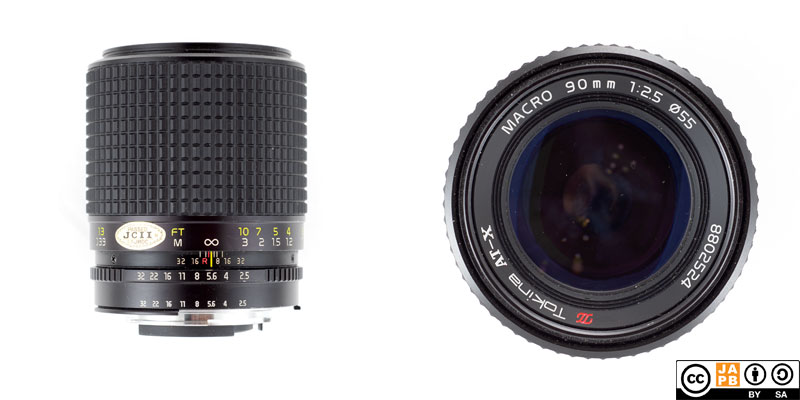Pekka Buttler, 03/2023

Specifications
The table below summarises the lens’ key specifications (measurements based on pictured sample):
| Brand: | Tokina | Lens name | AT-X Macro 90mm 1:2.5 |
| Focal length(s) 1 | 90 mm | Angle-of-view 2 | 27° |
| Maximum Aperture | f/2.5 | In Production | 1986–1997 |
| Lens mounts (this lens) | Nikon F | Other lens mounts | Canon FD, Contax/Yashica, Minolta SR, Olympus OM, Pentax K |
| Length 3 | 77,0 mm | Diameter 4 | 66,7 mm |
| Filter ring diameter | 52 mm | Weight | 513 grams |
| Lens element count | 8 | Lens group count | 7 |
| Aperture blades (S/R/C) 5 | 8 S | Focus throw | 290 ° |
| Minimum focusing distance | 39 cms | Maximum magnification | 1:2 |
| Has manual aperture ring | YES | Has Manual focus ring | YES |
| Aperture mechanism type | Automatic | Aperture click stops 6 | 2.5-4•5.6•8•11•16•22-32 |
Further notes:
• This lens is widely known as ‘the Bokina’ because of its especially pleasing way of rendering out-of-focus areas (both behind and in front of the focal plane).
• This lens has a maximum magnification of 1:2 at MFD. Tokina used to offer a dedicated ‘Macro extender’ that would bring the lens to 1:1. Interestingly, that ‘Macro extender’ was not just an extension tube, but contained some optics to improve close-up performance.
• Before 1986 Tokina produced a very similar lens exclusively for Vivitar (the Vivitar Series 1 90mm f/2.5 Macro). After Vivitar discontinued that lens, Tokina decided to redesign the lens slightly and sell it as part of the Tokina AT-X (premium) series.
• The Vivitar and Tokina versions differ in that the Victor version is more bulky (size, weight, filter thread) and in that Tokina upgraded the lens’ coatings before launching it as a Tokina lens.
• Alike all traditional macro lenses, the lens focuses by moving the entire objective (set of lenses) away from the film plane. Hence the focusing to MFD entails a significant lengthening of the lens (see below).
• Because the front-element is relatively exposed, using a lens hood might be advisable, even though the lens is not especially prone to flaring (any generic 55 mm thread short tele hood will do).
• This lens was later replaced by the ‘Tokina AT-X 100 AF PRO 100mm 1:2.8 Macro’.

Right: Focused at MFD
History of Tokina
Tokina (originally Tokyo Optical Equipment Manufacturing) was founded in 1950 to act as an OEM manufacturer, initially making projector lenses but quickly diversifying into manufacturing camera lenses for other companies. Herein Tokina’s OEM business was always aimed at a) manufacturing lenses for sale by re-branders (companies selling others’ product under their own brand, such as Vivitar, Soligor…), and b) taking care of lens manufacturing for many major brand-operations (including Konica).
From the beginning, Tokina sometimes also sold its lenses under its own brand (first as Tokyo Koki Tele-Tokina’s, later under the name Tokina). Having seen Tamron’s success in using an intermediate mount, Tokina launched their own intermediate mount (the T-4/TX mount), even though the resulting lenses were most often sold under the Soligor and Vivitar brands.
After the effective end of intermediate mounts (due to the increasing dependence on electronics in lens-body communication) and the lessening importance of re-branders, Tokina ‘in-housed’ a lot of its lens manufacturing, increasingly selling their lenses under the Tokina brand.
Today, Tokina is part of the Hoya-Kenko-Tokina combined company, and is one of the few Japanese third-party lens manufacturers still in existence.
Adapting
Given that this lens exists in at least 6 different mount versions, the question of adapting is a bit complicated.
On dSLRs
If you have a Nikon F or Pentax K SLR/dSLR, you can use the Nikon F / Pentax K versions of this lens natively on your camera.
If you have a Canon EF or Sony/Minolta A dSLR, some of the versions of this lens (most prominently Nikon F) can be adapted using a simple adapter ring. However, metering will only work in stop-down mode.
On Mirrorless
Thanks to being a fully manual lens (manual aperture, manual focus), the lens can be adapted to all mirrorless cameras using a simple dumb adapter. Also, with most mounts that this lens was manufactured using, you will have a wide range of special adapters (e.g. helicoid adapters; tilt-shift adapters; speed boosters) available.
On Film
If you have a Canon FD, Contax/Yashica, Minolta SR Nikon F, Olympus OM or Pentax K Film SLR, you can use the respective versions of this lens natively on your camera 7.
Footnotes
- Focal length is (unless stated otherwise) given in absolute terms, and not in Full-frame equivalent. For an understanding of whether the lens is wide/tele, see ‘Angle-of-view’. ↩︎
- Picture angle is given in degrees and concerns the diagonal picture angle. Rule of thumb:
> 90 ° ==> Ultra-wide-angle
70–90 ° ==> Wide-angle
50–70 ° ==> Moderate wide-angle
40–50 ° ==> ‘Standard’ or ‘normal’ lens
20–40 ° ==> Short tele lens
10-20 ° ==> Tele lens
5-10 ° ==> Long tele lens
< 5 ° ==> Ultra-tele lens ↩︎ - Length is given from the mount flange to the front of lens at infinity. ↩︎
- Diameter excludes protrusions such as rabbit ears or stop-down levers. ↩︎
- S=straight; R=rounded; C=(almost)circular at all apertures. ↩︎
- Numbers equal aperture values on aperture ring; • intermediate click; – no intermediate click. ↩︎
- When doing macro photography on a Film SLR, remain mindful of effective aperture. ↩︎